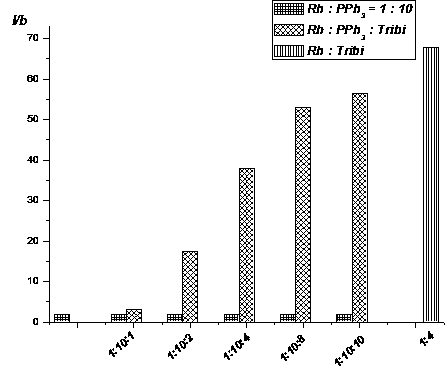Preparation method of biphenyl triphosphane ligand and application thereof in gradually substituting PPh3 (Triphenylphosphine) in hydroformylation
A technology of biphenyl triphosphine and phosphine ligands is applied in chemical instruments and methods, carbon monoxide reaction preparation, organic compound/hydride/coordination complex catalysts, etc., and can solve the problems of low reaction rate, poor selectivity and high cost , to achieve the effect of high reaction rate, high selectivity and low cost
- Summary
- Abstract
- Description
- Claims
- Application Information
AI Technical Summary
Problems solved by technology
Method used
Image
Examples
Embodiment 1
[0028] Preparation of 2,2′,6-trimethylbiphenyl:
[0029]
[0030] Add 2.06g of Pd to the 2L Schlunk bottle successively 2 (dba) 3 (tris(dibenzylideneacetone) dipalladium), 1.56 g of HPtBu 3 BF 4 (tri-tert-butylphosphine tetrafluoroborate), 66.76 g of 2-methylphenylboronic acid, 139.75 g of potassium fluoride dihydrate. After the addition was complete, the reaction bottle was replaced with a nitrogen atmosphere. Under nitrogen protection, 76.95 g of 2,6-dimethylbromobenzene and 1 L of anhydrous THF (tetrahydrofuran) were added to obtain a reaction system. The reaction system was reacted at room temperature for 5 hours, THF was spin-dried under reduced pressure, 400 mL of water was added, and extracted three times with ethyl acetate (500 mL of ethyl acetate each time), the obtained organic phase was dried over anhydrous sodium sulfate and then spin-dried under reduced pressure , and the residue was subjected to flash column chromatography to obtain 80.35 g of the target ...
Embodiment 2
[0033] Preparation of 2,2′,6-tricarboxybiphenyl:
[0034]
[0035] Into a 2L four-neck round bottom flask, 26.7g of 2,2',6-trimethylbiphenyl, 2.44g of cetyltrimethylammonium bromide and 1.2L of water were added in sequence to obtain a reaction system. Raise the reaction system to 80°C and add 193.4g of potassium permanganate to react for 12 hours until the red color of potassium permanganate in the system to be reacted fades. The reaction system was filtered to obtain a colorless water phase. After extracting with toluene to remove cetyl ammonium bromide in the colorless water phase, the obtained water phase was rotary evaporated under reduced pressure to about 150 mL, and 50 mL of concentrated hydrochloric acid was added. At this time, a white solid was precipitated, and the white solid was filtered and dried in a vacuum oven to obtain 95.75 g of the target compound (4), with a yield of 82%. 1 H NMR (400MHz, CD 3 OD):δ=8.02-8.06(m,3H),7.47-7.53(m,2H),7.38-7.42(m,1H),7.05...
Embodiment 3
[0038] Preparation of 2,2′,6-tris(methylcarboxylate)-biphenyl:
[0039]
[0040] Add 95.0g of 2,2′,6-tricarboxylic acid biphenyl to a dry 1L Schlenk bottle, replace the Schlenk bottle with a nitrogen atmosphere, add 400mL thionyl chloride at 0°C, and reflux for 24 hours , After removing excess thionyl chloride by rotary evaporation under reduced pressure, a light yellow solid was obtained. Subsequently, under the protection of nitrogen, 250mL of anhydrous methanol and 150mL of anhydrous triethylamine were added, and heated to reflux for 5 hours. After the reaction solvent was removed by rotary evaporation under reduced pressure, 300mL of water was added and extracted three times with ethyl acetate (each time using acetic acid ethyl ester 400mL). The obtained organic phase was dried over anhydrous sodium sulfate and then spin-dried under reduced pressure to obtain a light yellow solid, which was recrystallized in petroleum ether and ethyl acetate to obtain 98.07 g of the wh...
PUM
 Login to View More
Login to View More Abstract
Description
Claims
Application Information
 Login to View More
Login to View More - R&D
- Intellectual Property
- Life Sciences
- Materials
- Tech Scout
- Unparalleled Data Quality
- Higher Quality Content
- 60% Fewer Hallucinations
Browse by: Latest US Patents, China's latest patents, Technical Efficacy Thesaurus, Application Domain, Technology Topic, Popular Technical Reports.
© 2025 PatSnap. All rights reserved.Legal|Privacy policy|Modern Slavery Act Transparency Statement|Sitemap|About US| Contact US: help@patsnap.com



